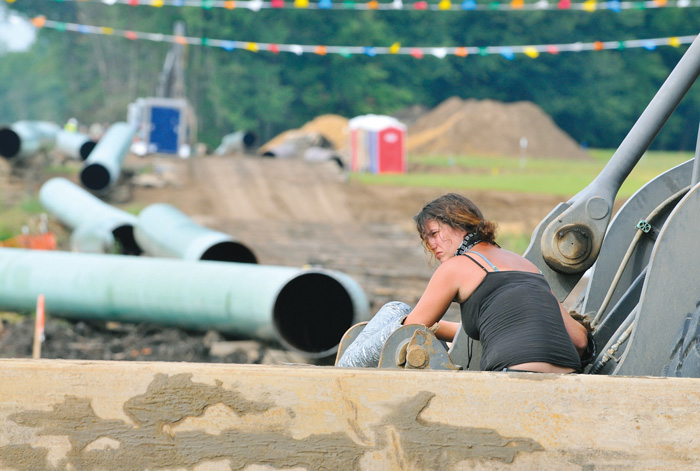Fight over Keystone XL project fails to hold up pipeline boom


Lansing State Journal
A protester from the Michigan Coalition Against Tar Sands group is locked to heavy equipment at an Enbridge pipeline construction site near Stockbridge, Mich. The group fought the project, saying Enbridge should not be able to expand the capacity of its old pipeline and raising fear of pipeline leaks. The Michigan Public Service Commission ruled the project and route, which replaced an old pipeline that had spilled, were acceptable. AP file photo, July 22, 2013 Lansing State Journal
Associated Press
WASHINGTON
In a far corner of North Dakota, just a few hundred miles from the proposed path of the Keystone XL pipeline, 84,000 barrels of crude oil per day recently began flowing through a new line that connects the state’s sprawling oilfields to an oil hub in Wyoming.
In West Texas, engineers activated a new pipeline that cuts diagonally across the state to deliver crude from the oil-rich Permian Basin to refineries near Houston. And in a string of towns in Kansas, Iowa and South Dakota, local government officials are scrutinizing the path of pipeline extensions that would pass nearby.
While the Keystone project awaits a final decision, scenes like these are unfolding almost every week in lesser-known developments that have added more than 11,600 miles of pipeline to the nation’s domestic oil network.
Overall, the network has increased by almost a quarter in the last decade. And the work dwarfs Keystone. About 3.3 million barrels per day of capacity have been added since 2012 alone — five times more oil than the Canada-to-Texas Keystone line could carry if it’s ever built.
The pipeline build-out provides a little-noticed counterpoint to the fierce political battle being waged over the 1,179-mile Trans-Canada project, which is still in limbo seven years after it was proposed. During the wait for Keystone, the petroleum industry has pushed everywhere else to get oil to market more efficiently, and its adversaries have been unable to stop other major pipelines.
“There’s been a lot of growth — we’re really positive on it in general,” said Rob DeSai, an equity analyst with Edward Jones who focuses on the energy industry. “The oil that’s being produced in the U.S., in many cases, it’s basically in the middle of nowhere. You need new infrastructure to get that oil to market.”
Environmental groups have fought Keystone by citing the risk of leaks and the climate-change consequences of fossil fuels. They hope to make cleaner energy options more appealing. Their success has inspired protest groups to challenge more projects.
But those efforts, while slowing a few pipelines, have not stopped any because the regulatory path is smoother when a pipeline does not cross an international border, as Keystone would.
Since 2012, more than 50 pipeline projects have been approved, completed or are under development.
 43
43
